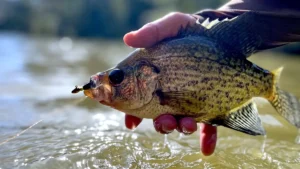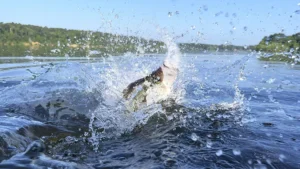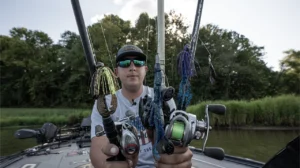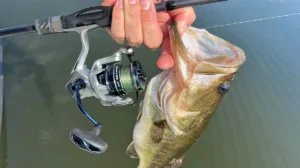Growing up, I could always count on a certain fish to make my day. One that was always willing to bite and put a good bend into an ultralight. That species has made its way into the hearts and freezers of millions of Americans nationwide. You likely know it as the bluegill. For fishermen across the country, bluegills are often considered a stepping stone into getting hooked on fishing. They’re in most freshwaters across the country, and growing in abundance around the globe. Plus, panfish are relatively easy to catch.
While bluegills are widespread, finding big bluegills can be a challenge, especially catching them consistently. Standard tactics will work, but there are certain baits and presentations that work better to specifically weed out the smaller ‘gills. Here are a few ways to fill your livewell with bull bluegills this upcoming summer.
Where Do the Big Ones Hide?

Before we get into the tips and tactics, first consider where big bluegills like to hangout. Now, you may think they just mingle in the shallows with the rest of the other bluegills — and sometimes that’s true. But what I’ve generally noticed, at least here in the northeast, is that bluegills tend to school by size. Usually the larger fish tend to be on their own and relate more to structure. Almost like a smallmouth, when you find one big one, generally you’ll find more.
Big “bull” ‘gills tend to gravitate more to structure like a bass would. They like to be right in the thick of it. But hey, they got that big for a reason! When looking for big bluegills, look for structures that have lots of nooks and crannies, such as larger standing docks, laydowns, and standing vegetation growing around rock. This gives these large bluegills something to hide in and ambush prey. You may think these bulls are considered “peckers” due to their shape and ability to pick invertebrates off weeds, but they will chase other fish and go after larger prey.
Go Big or Go Home

I’m sure while bass fishing, you’ve hooked into large bluegills on full-size baits. Whether it’s a jerkbait or popper, big bluegills will chase and attack it. That being said, have you tried upsizing your bluegill baits to draw more strikes? Big bulls are curious creatures and want to check out everything. Upsizing your bait will usually attract more curious bluegills.
There are many bass-style baits that excel in this scenario. Baits like the Rapala X-Rap in size 04 or a Rebel Teeny Pop-R are recognized for landing huge panfish, especially large bluegills. I believe the feathered tails excite the bite most of all. Both of these baits come equipped with feathered trebles on the back of the bait. When a bluegill follows the bait, that fluttering of the feathered treble moves enticingly.
Never Underestimate a Soft Swimbait

Over the past few seasons of panfishing here in New York’s Finger Lakes, I always threw smaller boot-tail swimbaits for a variety of panfish species. I’d find myself accidentally catching these giant bluegills. Not a ton, just one here or there. I decided to downsize the bait to a two-inch tail on a small, light-wire jighead. It worked. This turned out to be one of my top producing big bluegill techniques for both myself and charter clients.
Bluegills don’t feed much on baitfish, but when there is large amounts of young-of-the-year bait around, it’s hard for big gills to resist an easy meal. All it takes is a slow-rolling retrieve back to the boat and the bite is ferocious. For baits, a two-inch Keitech Swing Impact on a 1⁄16-ounce jighead fits the bill perfectly. Its squid scent and ultra-tight swimming motion drive bull ‘gills to bite. The super-soft rigidity generates incredible action in the water.
Drop Shots Are Key for Summer Success

Usually when you’re trying to fish a finesse approach for bass in the summertime, odds are you’re throwing a drop shot rig. It’s a technique where you can suspend a soft plastic next to a piece of structure while still maintaining bottom contact. Around vegetation, you get pecked to pieces by bluegills. It happens so often, so why not downsize your bait and up your odds for landing those big bulls?
The biggest key is not downsizing too small. When your bait is too small, you’ll just be messing with small bluegills all day. The bait has to be the right size in order to entice the bigger fish but filter out the smaller ones. My go-to bluegill drop shot baits are a Reins Rockvibe Shaker and a Charlie Brewer’s Slider Grub. Both baits offer a subtle action when worked on a drop shot rig. It drives bulls crazy. The bite is subtle on a drop shot, so having the right lightweight combo is key.
Wind and Slip Floats for Bluegills
A bluegill trip wouldn’t be complete without someone throwing a float rig with a bait suspended underneath. Think of it like the peanut butter and jelly of bluegill fishing — they just go hand in hand. But, this is a little more complicated than a red-and-white bobber with a piece of nightcrawler. In today’s world, float fishing has come a long way. What’s always been a killer technique for big ‘gills is a slip float with a quality piece of plastic suspended underneath. There’s one key factor you need to manage — that’s wind.
Roy Bilby, a competitive angler and pro staffer with Bass Pro Shops, knows this game all too well. Bilby says, “You need some sort of wind and chop on the water to effectively fish a slip float. Without it, [the presentation] would look extremely unnatural and those big bluegills just swim by.” Wind allows the float to have an ideal up-and-down action, allowing for natural movement of the bait.
Thill makes a variety of floats in all shapes and sizes, as well as bobber stops to keep the float pegged. When it comes to baits, Bilby loves the Bass Pro Shops Lil’ Beaver on a small jighead, as it imitates many of the smaller freshwater shrimp that bluegills love to eat.
Having the Right Lightweight Setup

When it comes to fighting and handling big bluegills, the proper rod, reel and line combination is key for landing the fish, as well as placing the bait in the right spot. I have two main setups that I use. One is a custom built Mud Hole MHX Ultralight blank in a seven-foot, light-action rod with a fast tip. I pair this with a 2000-size Shimano Vanford reel to six-pound braid and six-pound fluorocarbon leader. This is my small swimbait or slip-float rod. It has the perfect length to get the baits out there, plus the fluorocarbon leader allows for a little bit of stretch, while still being able to feel every bite.
For my bottom- and hard-bait setup, I run a 6-foot, 6-inch G Loomis GCX Panfish rod with a light action and fast tip. The rod is paired with a 1000 Shimano Ultegra and has the same line setup as my other rod. It truly is a combination that has the sensitivity I need to feel strikes, but also enough give to handle those hard baits.
—
Bluegills open the door to all kinds of fishing. Everyone at some point starts their fishing fanaticism with a bluegill catch. But, since getting big bulls consistently is challenging, the tips included here will shorten the learning curve to bigger ‘gills. These tactics are what I use on a weekly basis while guiding clients and the results speak for themselves.














